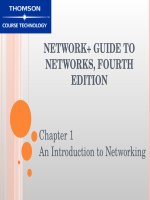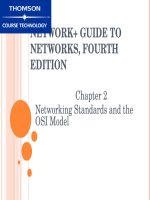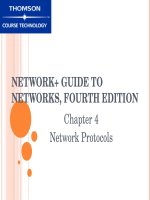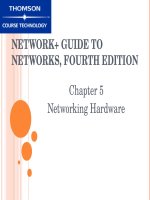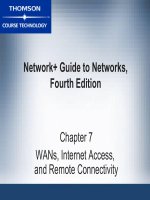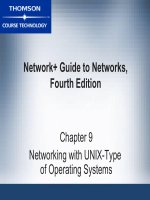Guide to network essentials 4th chapter 06
Bạn đang xem bản rút gọn của tài liệu. Xem và tải ngay bản đầy đủ của tài liệu tại đây (1.88 MB, 59 trang )
Chapter 6:
Network Communications
and Protocols
Learning Objectives
Understand the function and structure of
packets in a network, and analyze and
understand those packets
Understand the function of protocols in a
network
Discuss the layered architecture of
protocols,
and describe common protocols and their
implementation
Understand channel access methods
Guide to Networking Essential
2
Function of Packets in Network
Communications
Networks reformat data into smaller, more
manageable pieces called packets or frames
Advantages of splitting data include:
More
efficient transmission, since large units of data
saturate network
More computers able to use network
Faster transmissions since only packets containing
errors need to be retransmitted
Guide to Networking Essential
3
Packet Structure
Three basic parts of packet, as seen in
Figure 6-1:
Header
– contains source and destination address
along with clocking information to synchronize
transmission
Data – payload or actual data can vary from 512
bytes to 16 kilobytes
Trailer – information to verify packet’s contents, such
as Cyclic Redundancy Check (CRC)
Guide to Networking Essential
4
Typical Packet Structure
Guide to Networking Essential
5
Packet Creation
From sender, data moves down layers of
OSI model
Each
layer adds header or trailer information
Data travels up layers at receiver
Each
layer removes header or trailer information
placed by corresponding sender layer
See Figure 6-2
Guide to Networking Essential
6
Header/Trailer Information Added or
Removed
Guide to Networking Essential
7
Packet Creation (continued)
Outgoing data stream enters OSI model as
complete message
Remains
as data at layers 5-7
Lower layers split data
Transport
layer 4 splits it into segments
Network layer 3 splits segments into packets
Data Link layer 2 puts packets into frames
Physical layer 1 transmits packets as bits
Guide to Networking Essential
8
Understanding Packets
Three kinds of packets:
Unicast
packet – addressed to only one computer
Broadcast packet – created for all computers
on network
Multicast packet – created for any computers
on network that “listen” to shared network
address
Guide to Networking Essential
9
Protocols
Rules and procedures for communicating
To communicate, computers must agree
on protocols
Many kinds of protocols:
Connectionless
Connection-oriented
Routable
Nonroutable
Guide to Networking Essential
10
The Function of Protocols
Each protocol has different purpose and function
Protocols may work at one or more layers
More sophisticated protocols operate at higher
layers of OSI model
Protocol stack or protocol suite is set of
protocols that work cooperatively
Most common protocol stack is TCP/IP used by
the Internet and pretty much all operating
systems
Guide to Networking Essential
11
Protocols in a Layered Architecture
Most protocols can be positioned and explained
in terms of layers of OSI model
Protocol stacks may have different protocols for
each layer
See Figure 6-3 for review of functions of each
layer of OSI model
See Figure 6-4 for three major protocol types
Application protocols at layers 5-7
Transport protocols at layer 4
Network protocols at layers 1-3
Guide to Networking Essential
12
Functions of OSI Model Layers
Guide to Networking Essential
13
Three Main Protocol Types
Guide to Networking Essential
14
Network Protocols
Provide addressing and routing information, error
checking, and retransmission requests
Services provided by network protocols are called
link services
Popular network protocols include:
Internet Protocol version 4 (IPv4)
Internetwork Packet Exchange (IPX) and NWLink
NetBEUI
Internet Protocol version 6 (IPv6)
Guide to Networking Essential
15
Transport Protocols
Handle data delivery between computers
May be connectionless or connectionoriented
Transport protocols include:
Transmission
Control Protocol (TCP)
Sequenced Packet Exchange (SPX) and NWLink
NetBIOS/NetBEUI
Guide to Networking Essential
16
Application Protocols
Operate at upper layers of OSI model to
provide application-to-application service
Some common application protocols are:
Simple
Mail Transport Protocol (SMTP)
File Transfer Protocol (FTP)
Simple Network Management Protocol (SNMP)
NetWare Core Protocol (NCP)
AppleTalk File Protocol (AFP)
Guide to Networking Essential
17
Common Protocol Suites
Combination of protocols that work
cooperatively to accomplish network
communications
Some of the most common protocol suites
are:
TCP/IP
NWLink (IPX/SPX)
NetBIOS/NetBEUI
AppleTalk
Guide to Networking Essential
DLC
XNS
DECNet
X.25
18
Transmission Control Protocol/ Internet
Protocol (TCP/IP)
Called the Internet Protocol (IP)
Most commonly used protocol suite for networking
Excellent scalability and superior functionality
Able to connect different types of computers and
networks
Default protocol for Novell NetWare, Windows
XP/2000/2003, all Unix/Linux varieties, and Mac OS X
See Figure 6-5 for relationship to OSI model
Guide to Networking Essential
19
TCP/IP Compared to OSI Model
Guide to Networking Essential
20
IP Addressing
Logical addresses, 32-bits or 4 bytes long
Four octets separated by periods, each with
decimal value from 0-255
First part of address identifies network
Second part of address identifies host or
individual computer
IP addresses broken into classes
Number of IP address registries under control
of Internet Assigned Numbers Authority (IANA)
Guide to Networking Essential
21
Classless Inter-Domain Routing (CIDR)
Internet uses CIDR
Demarcation between network and host not
always based on octet boundaries
May be based on specific number of bits
from beginning of address
Called subnetting, the process involves
“stealing” bits from host portion of address
for use in network address
Provides
fewer hosts on each network but
more networks overall
Guide to Networking Essential
22
Subnet Masks
Part of IP address identifies network and part
identifies host
IP uses subnet mask to determine what part
of address identifies network and what part
identifies host
Network
section identified by binary 1
Host section identified by binary 0
Guide to Networking Essential
23
Network Address Translation (NAT)
Allows organization to use private IP
addresses while connected to the Internet
Performed by network device such as router
that connects to Internet
See Simulation 6-3 and Figure 6-6 for
examples of NAT
Guide to Networking Essential
24
Network Address Translation (NAT)
(continued)
Guide to Networking Essential
25

